Contact
University of Arkansas System Division of Agriculture
Cooperative Extension Service
2301 S. University Avenue
Little Rock, AR 72204
Summer Garden Insect Pests in Arkansas
Bugs can become abundant in the summer months. It is important to scout your garden often for bugs so that they will not go unnoticed and take over. Identification is key to treating pests.
Below is a list of common summer insect pests:
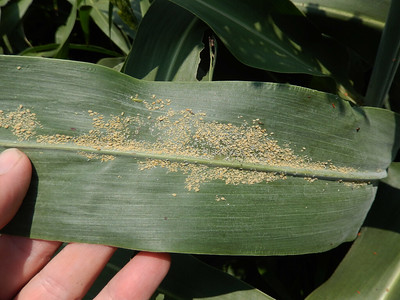
Aphids are the rabbits of the insect world, giving birth to living young and spreading quickly. Aphids have one of the widest ranges of host plants of any insects—from flowers to vegetables, shrubs and trees, they are equal opportunity feeders. The tiny pear-shaped, soft bodied insect can be green, brown, white, black, yellow or pink in color.
Both the adult and the nymph stages feed on plants, sucking sap out of the plant and giving off a sweet substance called honeydew. Honeydew can fall on leaves and stems, or on car windows or patio furniture and cause a sticky residue. If the residue stays on the surface long enough, a black sooty mold will form on the residue, which can cover a plant, cutting down on photosynthesis. Aphids have a piercing sucking mouthpart which is similar to sticking a small straw into the stem and sucking out its juices. While they can feed on any plant parts, they prefer the tender new growth and often cluster together as a group to feed.
Controlling aphids
Aphids are not difficult to kill, but they tend to get out of hand quickly if you
don’t watch for them. A spray of water can knock down a small group, or you can use
insecticides including insecticidal soap. If you have lady bug beetles around, let
them do the job, since they love to feast on aphids.
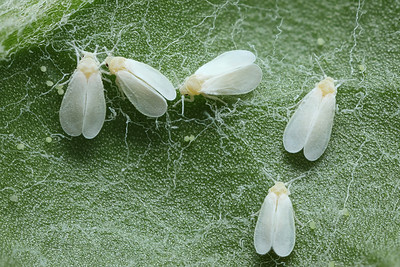
Whiteflies are soft-bodied, winged insects closely related to aphids and scales and also feed by sucking sap from the plants. They typically feed on the undersurface of the leaves, and lay their eggs there as well. Each female can lay between 400-500 eggs in cluster, so you can see how they can multiply. The adults are small, usually less than ½ inch in size, clustered together on the bottom of the leaves. They have four broad, delicate wings that are held roof-like over the body and covered with a white powdery wax.
Whiteflies are active during the day when temperatures are warm. If you are near a plant with an infestation of whiteflies it can appear like floating dandruff when you disturb the plant. Eggs are also laid on the undersides of the leaves, typically in clusters.
Controlling whiteflies
Whiteflies can be challenging to control. Contact insecticides like insecticidal soap
can work, but they must come in contact with the insect which is typically on the
bottom of the leaves. They are attracted to the color yellow, so you can make a sticky
trap to catch them by taking a 12-by-6-inch strip of cardboard or strong poster board.
Paint both sides bright yellow and coat with a sticky substance, such as Tanglefoot,
petroleum jelly, petroleum jelly/mineral oil mix, or mineral oil. Hang the trap vertically
or support it on stakes just above the plants. The adults are attracted to the yellow
color and become trapped on the sticky substance. Whitefly traps are available commercially
also. Whiteflies can attack a wide variety of plants, from ornamentals to edibles,
but gardenias are one of their favorite hosts.
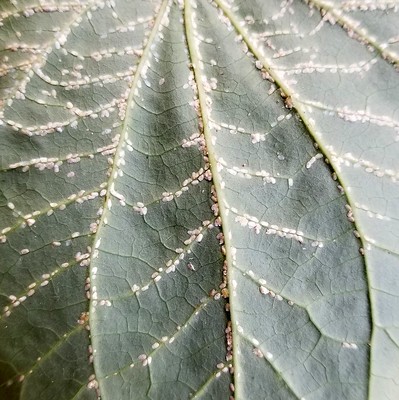
Related to aphids and whiteflies, there are a wide range of insects in the scale family. Scale insects are generally divided into two categories, soft scales and armored or hard scales.
How to identify scale in gardens
Soft scales produce a soft, thin covering which can be cottony, powdery or waxy in
nature. This layer covers the insect and cannot be separated from the insect body.
Soft scales insects often produce copious amounts of the sweet honeydew resulting
in black sooty mold forming on leaves and trunks of infested plants.
Armored scales have a hard, shield-like cover that conceals the body but is not attached to the body of the insect. This hard shell is composed of shed skins and wax.
Scale insects attach themselves to plant parts using their piercing-sucking mouthparts and feed on plant sap. Once they attach themselves, they don’t move. Individual scales may look like oval or rod-shaped bumps, ranging in color from white, yellow, grey, brown to black.
These insects can be a major problem on many shrubs and trees. Heavy infestations of scale insects can cause yellowing or mottling of foliage and premature leaf drop. In the case of the crape myrtle felt scale, they also decrease the number of flowers. Scale insects rarely kill a plant, but a plant weakened by a scale population is often more susceptible to damage by a secondary insects or diseases that may ultimately kill the plant. While they do attack a wide range of ornamentals, including the crape myrtle, they are also very common on golden euonymus, camellias and hollies.
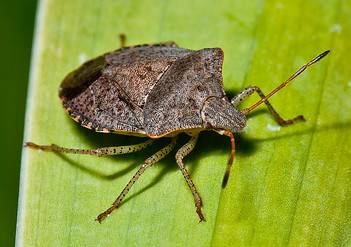
Stinkbugs are another insect pest which feed on a wide range of plants, including fruits, vegetables and ornamentals. Stinkbugs range in color from brown to brilliant green, although many have a dull shade designed to blend in with the plants they are feeding on. Nearly all species are distinguished by a triangle-or shield-shaped plate on their backs. Stinkbugs are part of an order of insects sometimes called "true bugs," which do not chew with their mouths; instead, they have a piercing/sucking mouthpart that allows them to suck the sap out of what they are feeding on. There are multiple generations per year. Females typically lay eggs in a cluster on the surface of the leaf. (The related squash bug, lays her eggs on the undersurface of the leaf.) The eggs hatch in about a week, and the nymphs look like tiny adults, and take about 4 weeks to reach maturity.
At night, they are attracted to light and therefore can sometimes be seen flying around outdoor lights. Often, they hang around some of their favorite host plants, especially tomatoes, melons, and beans. When they feed on tomatoes and peaches, they can create ugly scars called "catfacing."
Controlling stinkbugs in gardens
Stinkbugs can be difficult to control because they are resistant to some insecticides
and the later in the season it is, the tougher they are to kill. Scout your garden
and if you see the egg clusters, rub them off. You can trap the adults by placing
melon rinds in the garden overnight. The insects will congregate under them to feed
and you can dispose of them in the morning. Be aware that they are aptly named. When
disturbed or killed they can give off a noxious odor.
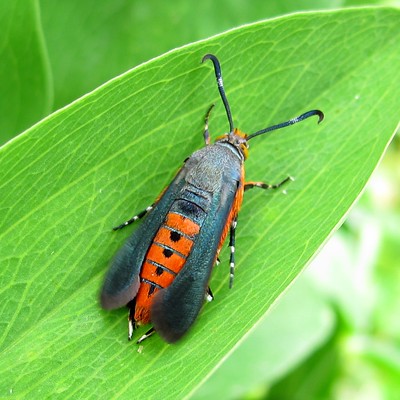
Squash vine borer is a serious pest problem on members of the cucurbit family, with summer and winter squash and pumpkins the most commonly attacked. It is less of a problem on melons or cucumbers.
Identifying squash vine borer
The adult is a clearwing moth which looks somewhat like a wasp. It is about 1/2 inch
long with an orange abdomen with black dots. Adults emerge in June from cocoons where
they overwintered in the ground. The wasp-like moths are unusual in that they fly
during the day, while most moths fly at night. The adult lays her eggs near stems
at the soil line. Eggs are small, flat, and brown, not readily visible. The larvae
hatch in about a week and begin to tunnel into the stem to feed. They are white or
cream-colored with brown heads, and will eventually grow to almost an inch in length.
The larvae feed for four to six weeks and then burrow back into the ground to pupate.
Squash vine borers have two generations a year in Arkansas with the second coming
in August.
Controlling squash vine borer
The key to squash vine borer management is controlling the borers before they enter
the stem. Once inside the vine, insecticidal control is ineffective. Poor timing of
sprays is the usual cause of inadequate control.
Adult emergence occurs in the early summer, usually around mid June. At this time, begin monitoring plants weekly for initial signs of the borer's frass at entrance holes in the stems. Very early signs of larval feeding indicate that other eggs will be hatching soon. Use two insecticide applications 7 days apart to control newly hatching larvae and continue to monitor for additional activity. Sprays need to penetrate the canopy to cover the vines to be effective.
The following insecticides are examples of materials that are available to homeowners and will provide adequate control of squash vine borers if applied properly: acetamiprid, (Ortho Max Flower, Fruit & Vegetable Insect Killer 0.006%), bifenthrin, (Ortho Bug-B-Gon MAX Lawn & Garden Insect Killer Concentrate 0.3%), spinosad (Ferti-lome Borer, Bagworm, Leafminer & Tent Caterpillar Spray 0.5%, Monterey Garden Insect Spray 0.5%), and permethrin (Eight Insect Control 2.5%, Bonide Total Pest Control Concentrate 13.3%).*
For more information Download the Squash Vine Borer Control Factsheet
See our Squash Vine Borer Q&A
If you are not already inspecting the squash plants in your home garden, then you
should really think about starting now. Squash bugs, Anasa tristis (DeGeer), will
feed on all cucurbits, but squash (especially yellow squash) and pumpkins are preferred.
Colonies of feeding adults and nymphs suck plant juices through piercing sucking mouthparts.
However, plant damage results from the injection of a toxic substance that causes
vines to wilt and die. These bugs will also feed on fruit if present. This insect
pest is also a vector of the cucurbit yellow vine disease bacterium.
Squash bugs overwinter as adults in plant debris or in protected areas in woods or
other sheltered areas near the garden site. Only one generation of squash bugs occur
each year, but because of the extended egg-laying period, adults and nymphs are present
throughout the summer.
How to identify squash bugs
Adult squash bugs are about 5/8 inch long, flat backed, and brownish in color. Over-wintered
females will begin laying eggs in the garden in early summer. 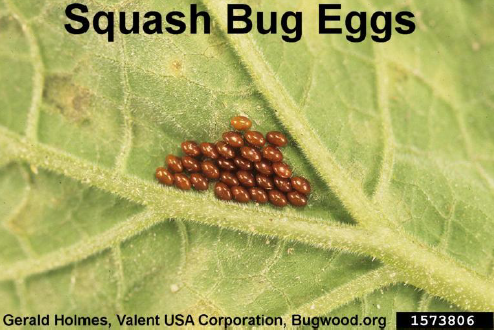 The female squash bug lays groups of 7 to 20 shiny bronze to brick red colored eggs
in rows on the undersides of leaves usually at leaf vein junctions. Nymphs hatch from
eggs after about 7 to 10 days. Young nymphs continue to remain together in a group
and begin to feed on the underside of leaves.
The female squash bug lays groups of 7 to 20 shiny bronze to brick red colored eggs
in rows on the undersides of leaves usually at leaf vein junctions. Nymphs hatch from
eggs after about 7 to 10 days. Young nymphs continue to remain together in a group
and begin to feed on the underside of leaves.
The immature nymph stage lasts 5 to 6 weeks during which nymphs develop through 5
instars. Nymph coloration is variable ranging from greenish with a red head and legs
to dark greenish gray with a dark head and legs. The last two nymphal instars have
visible wing pads. 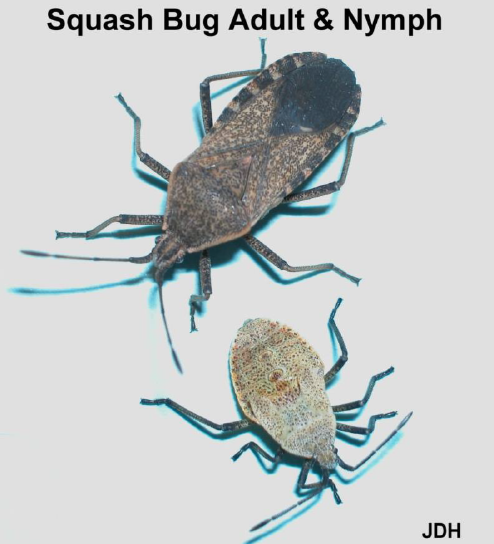 Overall, it takes 5 to 8 weeks for squash bugs to develop from egg to adult.
Overall, it takes 5 to 8 weeks for squash bugs to develop from egg to adult.
Controlling squash bugs
Cultural control methods for the homeowner include hand picking adults and egg masses
in small gardens. Squash bugs also have a tendency to aggregate in sheltered locations
and this behavior may be turned to your advantage. Bugs will congregate under boards
or shingles placed on the soil around plants and can be crushed or otherwise destroyed
each morning. Other things that will help lessen damage include maintaining healthy
vigorously growing plants through proper watering and fertilization and destruction
and removal of crop debris.
If chemical control is desired, be observant and do not let the squash bug population
get out of hand. Home gardeners should be aware that adult squash bugs are difficult
to kill. Control measures should be targeted against young nymphs as they are more
susceptible to insecticides.
Honeybees and other pollinators are very important in cucurbit production, and insecticide application can interfere with pollination by killing honeybees. If insecticides are to be applied when blossoms are present, it is advisable to use insecticides with little residual activity, and to apply insecticides late in the day, when honeybees are less active.
For more information on chemical control, download the Squash Bugs in the Home Garden Factsheet
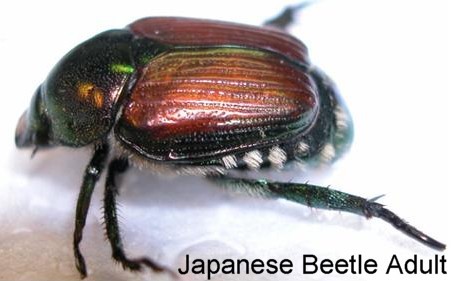 June through August is peak time for this invasive insect pest. If left untreated
Japanese beetles can cause severe damage to plants. The adults are very mobile, and
can invade new areas rapidly and can re-infest plantings that were treated successfully
several days earlier.
June through August is peak time for this invasive insect pest. If left untreated
Japanese beetles can cause severe damage to plants. The adults are very mobile, and
can invade new areas rapidly and can re-infest plantings that were treated successfully
several days earlier.
Their tendency to cluster together often results in clumps of severely damaged fruit or leaves near other completely undamaged portions of the same plant.
There are almost 30 million species of insects in the world, and some we couldn’t live without, but some we would rather not have in our lives. The key to success in the garden is regular scouting. The sooner you can catch a problem and properly identify it, the sooner you can begin to control it. If you aren’t sure if you have an insect or a disease, or you aren’t sure what insect is causing the problem, take a sample to your local county Extension office for a correct diagnosis.
Still have pest questions? We have answers.
Check out the Plant Health Clinic
Additional Resources
- Insecticide Recommendations for Arkansas - MP144
- Insect Pest Management in the Home Vegetable Garden
- Arkansas Pest Management - Insects, Weeds, and Plant Diseases
*All chemical information provided is given with the understanding that no endorsement of named products is intended, nor is criticism implied of similar products that are not mentioned. Individuals who use pesticides are responsible for ensuring that the intended use complies with current regulations and conforms to the product label. Before purchasing or using any pesticide, always read and carefully follow the label directions.